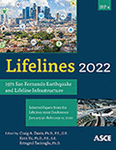Systemic Seismic Vulnerability and Risk Assessment of Urban Infrastructure and Utility Systems
Publication: Lifelines 2022
ABSTRACT
The seismic vulnerability and risk assessment of infrastructure and utility systems are essential to prevent or mitigate sufficiently the negative consequences, implement resilience management strategies, and recover efficiently after a major earthquake. In a complex urban environment, having multiple interacting and interdependent infrastructures becomes even more important. Earthquake hazards not only affect a single asset, but also their impact is much greater because of the inter- and intra-dependences among various infrastructure, utility systems, and lifelines. Therefore, we urgently need efficient tools to quantify and assess the systemic vulnerability and risk of urban infrastructure and utility systems. This is a challenging topic that is nowadays receiving more attention from the research community, the industry domain, and the policymakers. This paper aims to review the available modelling approaches and tools for the seismic risk analysis of interconnected systems, including advantages and limitations. It focuses in particular on the European funded SYNER-G project that encompasses interdependencies, delivers a holistic methodology, and implements a comprehensive framework based on the Object-Oriented Modelling paradigm. The capacities of the SYNER-G framework are illustrated through a selected application regarding the seismic risk analysis of interconnected infrastructure and utility systems in the city of Thessaloniki, Greece. Among other aspects, the paper discusses hazard modelling issues of the two common approaches, the probabilistic and the scenario-based procedure and illustrates in a specific example the impact of mitigation strategies, based on their effect on the performance of the interconnected systems and the overall loss reduction. The integration of interdependencies into the risk analysis and resilience strategies facilitates a better understanding of critical infrastructure operation and enables well-informed proactive and reactive decision-making and efficient disaster risk management, by infrastructure owners and operators, insurance companies, consulting agencies, and local authorities.
Get full access to this article
View all available purchase options and get full access to this chapter.
REFERENCES
Akkar, S., and Bommer, J. J. (2010). Empirical equations for the prediction of PGA, PGV, and spectral accelerations in Europe, the Mediterranean region, and the Middle East. Seismological Research Letters. Vol. 81, Nr. 2, S. 195–206.
ALA (American Lifelines Alliance). (2001). Seismic fragility formulations for water systems.
Argyroudis, S. A., Mitoulis, S.A., Winter, M. G., and Kaynia, A. M. (2019). Fragility of transport assets exposed to multiple hazards: State-of-the-art review toward infrastructural resilience. Reliability Engineering & System Safety. Vol. 191, S. 106567.
Cavallini, S., d’Alessandro, C., Volpe, M., Armenia, S., Carlini, C., Brein, E., and Assogna, P. (2014, March). A system dynamics framework for modeling critical infrastructure resilience. In International Conference on Critical Infrastructure Protection (pp. 141-154). Springer, Berlin.
Franchin, P. (2014). A Computational Framework for Systemic Seismic Risk Analysis of Civil Infrastructural Systems. In: Pitilakis, K., Franchin, P., Khazai, B., und Wenzel, H. (Hrsg.) SYNER-G: Systemic Seismic Vulnerability and Risk Assessment of Complex Urban, Utility, Lifeline Systems and Critical Facilities: Methodology and Applications. Springer Netherlands. Dordrecht. S. 23–56.
Giardini, D., Woessner, J., and Danciu, L. (2014). Mapping Europe’s Seismic Hazard. EOS, 95(29).
Hernandez-Fajardo, I., and Dueñas-Osorio, L. (2011): Sequential Propagation of Seismic Fragility across Interdependent Lifeline Systems. Earthquake Spectra. Vol. 27, Nr.1, S. 23–43.
Jayaram, N., and Baker, J. W. (2009). Correlation model for spatially distributed ground-motion intensities. Earthquake Engineering & Structural Dynamics. Vol. 38, Nr. 15, S. 1687–1708.
Kajitani, Y., and Sagai, S. (2009). Modelling the interdependencies of critical infrastructures during natural disasters: a case of supply, communication and transportation infrastructures. International journal of critical infrastructures. Vol. 5, Nr. 1–2, S. 38–50.
Nan, C., and Sansavini, G. (2017). A quantitative method for assessing resilience of interdependent infrastructures. Reliability Engineering & System Safety. Vol. 157, S. 35–53.
Ouyang, M. (2014). Review on modeling and simulation of interdependent critical infrastructure systems. Reliability Engineering & System Safety. Vol. 121, S. 43–60.
PCCIP. (1997). Critical foundations: protecting America’s infrastructures: the report of the president’s commission on critical infrastructure protection. Journal of Global Information Technology Management. Vol. 1, Nr. 1, S. 49–50.
Pitilakis, K., Riga, E., Anastasiadis, A., Fotopoulou, S., and Karafagka, S. (2019). Towards the revision of EC8: proposal for an alternative site classification scheme and associated intensity dependent spectral amplification factors. Soil Dynamics and Earthquake Engineering, 126, p.105137.
Pitilakis, K., Crowley, H., and Kaynia, A. M., eds. (2014a). SYNER-G: Typology Definition and Fragility Functions for Physical Elements at Seismic Risk. Springer Netherlands. Dordrecht.
Pitilakis, K., Franchin, P., Khazai, B., and Wenzel, H., eds. (2014b). SYNER-G: Systemic Seismic Vulnerability and Risk Assessment of Complex Urban, Utility, Lifeline Systems and Critical Facilities. Springer Netherlands. Dordrecht.
Rinaldi, S. M., Peerenboom, J. P., and Kelly, T. K. (2001). Identifying, understanding, and analyzing critical infrastructure interdependencies. IEEE control systems magazine. Vol. 21, Nr. 6, S. 11–25.
SRM-LIFE. (2007). Development of a global methodology for the vulnerability assessment and risk management of lifelines, infrastructures and critical facilities. Application to the metropolitan area of Thessaloniki., General Secretariat for Research and Technology, Greece.
Sun, L., Stojadinovic, B., and Sansavini, G. (2019). Resilience Evaluation Framework for Integrated Civil Infrastructure–Community Systems under Seismic Hazard. Journal of Infrastructure Systems. Vol. 25, Nr. 2, S. 04019016.
Weatherill, G., Esposito, S., Iervolino, I., Franchin, P., and Cavalieri, F. (2014). Framework for Seismic Hazard Analysis of Spatially Distributed Systems. In SYNER-G: Systemic Seismic Vulnerability and Risk Assessment of Complex Urban, Utility, Lifeline Systems and Critical Facilities. Springer Netherlands. Dordrecht. S. 57–88.
Zhang, Y., Yang, N., and Lall, U. (2016). Modeling and simulation of the vulnerability of interdependent power-water infrastructure networks to cascading failures. J. Syst. Sci. Syst. Eng. Vol. 25.
Information & Authors
Information
Published In
History
Published online: Nov 16, 2022
Authors
Metrics & Citations
Metrics
Citations
Download citation
If you have the appropriate software installed, you can download article citation data to the citation manager of your choice. Simply select your manager software from the list below and click Download.
